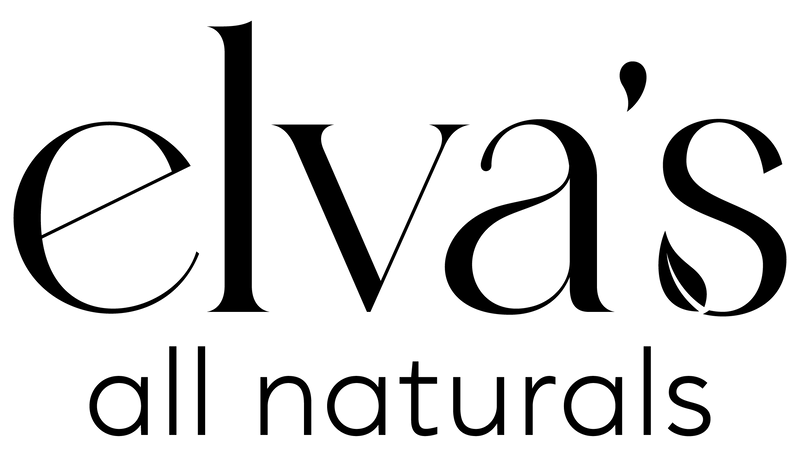Clean or Not? 🛑 What You NEED to Know Before You Buy
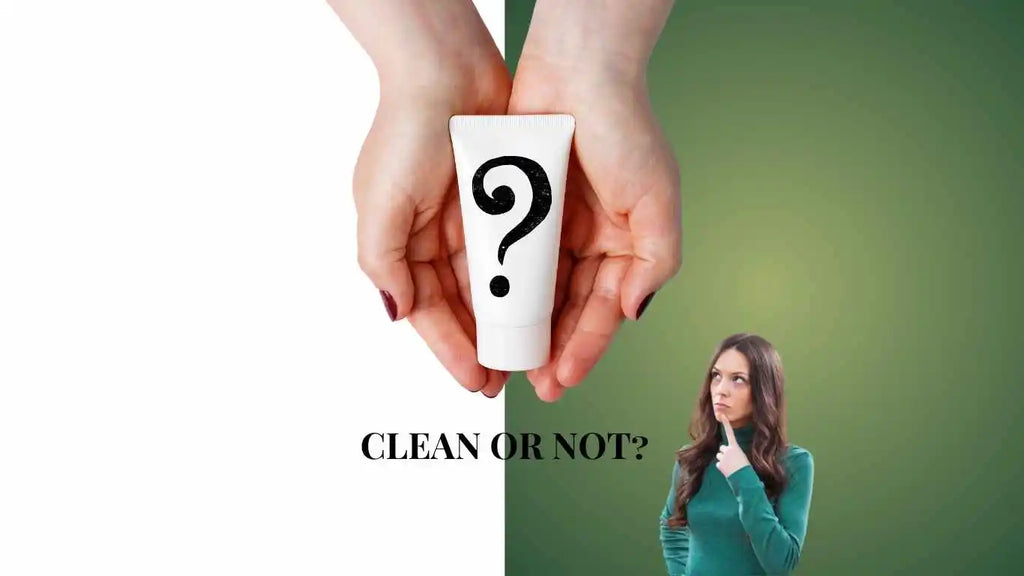
Why Outdated Regulations On Toxic Chemicals Are A Major Threat To Human Health
Preface from Kirsten, Co-Founder of Elva's All Naturals:
"In 2019, there was an afternoon that changed the course of my life. It was in the start-up phase of our company. I had the distinct pleasure of having two of the founding members of The Coalition for Action on Toxics over to our house for tea. (It almost felt like an episode of "Outlander", where the Scottish rebels were conspiring in secret against the British!) It somehow felt clandestine, rebellious and distinctly anarchial. How DARE we lowly consumers question the narrative, right??
Ignorance is bliss sometimes. I learned so much that day, including how the Canadian Environmental Protection Act (CEPA) is sadly, very out of date. We spent the afternoon talking about the horrors of politics, regulations, red-tape and big business blocking people from knowing the full truth about toxic chemicals still being marketed and sold to consumers as "safe" to use, while being fully banned in other countries. (And other ingredients that are present in cleaning products are some of the very worst offenders! While ads show a dish soap cleaning up oil spills, it ironically contains a chemical that kills fish.) And the thing that bugged me the most, was often people the most affected by these harmful chemicals are the poor, marginalized communities, and women. That's when Ian and I coined the term "The Toxic Chemical Rebellion" to describe a group of people like us who were no longer willing to accept what sleepy government was allowing and big industry was pushing onto consumers to use because it was MOST profitable. Toxic chemicals, petrochemicals and man-made synthetics are way cheaper than natural ingredients, of course. Money as a focus rarely puts people or our planet FIRST...We knew we had our work cut out for us, and had to take action to make sure our products would be truly CLEAN."
Quote from Michelle Murphy, Professor, Endocrine Disruptors Action Group (EDAction), (from Environmental Defence, and the Coalition for Action on Toxics' website):
“In the 18 years since the current CEPA [Canadian Environmental Protection Act] was enacted, scientific developments in our understanding of how chemicals affect health has advanced dramatically. These developments make it clear that current regulatory assumptions based on the notion of “safe thresholds” can no longer withstand scientific scrutiny, and in fact have discriminatory effects, where small doses harm fetuses, children, women, and especially poor and marginalized communities, more than others. Endocrine Disruptors Action Group (EDAction) strongly supports the recommendations of the Standing Committee on Environment and Sustainable Development. This is an urgent opportunity to address the shortcomings of CEPA that have led to the ongoing substitution of one harmful chemical for another.”
------------------------------------------------------
What's in the products YOU use every day?
Think soap, shampoo, deodorant, skin creams, lotion, makeup, cleaning products and more. Cleaning products you breathe in, the dish soap your hands soak in like a bath, the deodorant that sits all day in your armpits...

The average adult uses between 6 and 15 personal care products daily, containing roughly anywhere from about 112 to 170 chemicals*.
A 2020 Harvard study said the average woman uses about 12 products daily. [1]
Ok, so we get it - the products really add up over the course of the day! But what is more concerning is, that's A LOT of chemicals. Don't get me wrong - water is also technically a chemical compound - we're talking about the BAD chemicals. Toxic chemicals clearly linked to harming our health.
⚠️Canadian and US regulations allow for chemicals that are banned elsewhere for health and safety concerns to be included in consumer products.
Since our governments have fallen so far behind the science, it unfortunately places the onus on us as consumers to stay vigilant and informed. And, since most of us don't have a scientific background, it can be hard to navigate the plethora of information readily available on the internet.
The need is greater than ever to do your own research, read labels, buy clean and avoid what you simply don't want ending up in your bloodstream.
As the market becomes more and more flooded with new chemicals that don't have sufficient (or sometimes any) long-term studies done to support their safety, it raises serious cause for concern. It worries me greatly that there are chemicals present in Canadian and US products that wouldn't even be allowed for sale in The European Union (or "EU"). And, it's one of the big reasons we started our company and formulate - at a bare minimum - to EU ingredient standards (more on that later). That being said: there are still chemicals and man-made synthetics - many of petrochemical origin - that while "allowed" in EU, we would not even consider using them in our products as they do not meet our strict formulation standards at Elva's All Naturals.
The Skin's Microbiome and Chemical Absorption
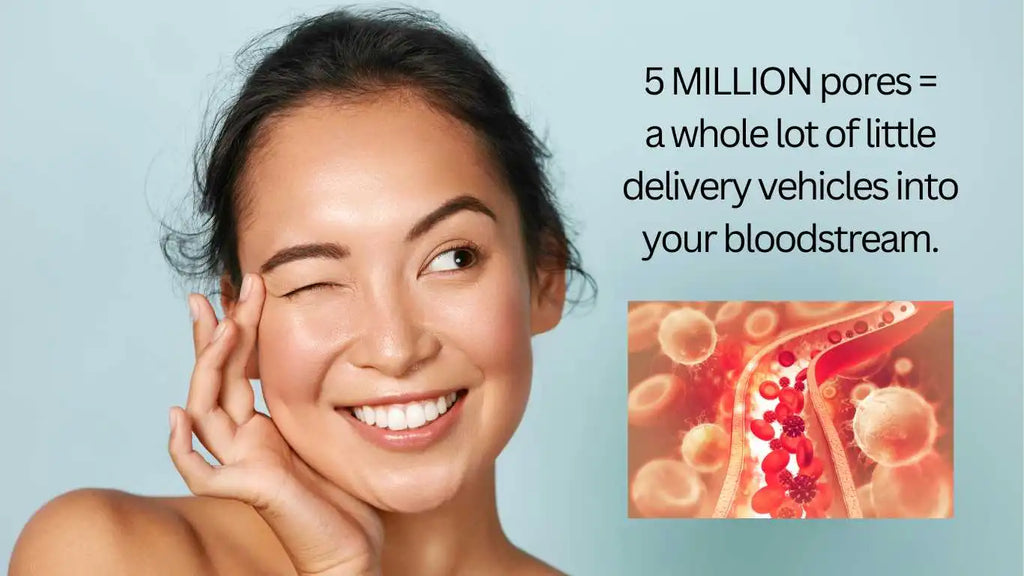
Your skin is your largest organ. And, did you know that we have approximately 5 million pores in our skin? Similar to the way plants and animals rely on the earth to survive, your body and your home are your ecosystems. Imagine the effects pollutants and chemicals in our homes and products have on our bodies if our skin is our largest organ - and, one of our bodies’ most penetrable organs.
Human skin is fascinating. Besides being a protective layer - it is much like a sponge and delivery vehicle into our bloodstream; it has its own microbiome with an ability to self-moisturize, self-repair, and self-hydrate. There are trillions of little bacteria and good critters on it that we even can't see, working around the clock to neutralize free radicals, bad bacteria, infections, restore moisture, etc. (When we use harsh soaps and cleansers, we interfere with our skin's microbiome - especially those with a high pH, which is basically most soap and shampoos! That's why the skin and hair products at Elva's are pH-balanced).
The skin's microbiome plays a vital protective part in human general health and wellness, and needs to be shielded from harsh chemical exposure. When we damage (or "strip") the skin's microbiome (and the outermost layer called the "stratum corneum"), our skin's surface can no longer defend us, and chemicals can more easily penetrate the skin and enter our bloodstream.
How much of those toxic ingredients are getting into our bloodstream, and building up in our internal organs and lymph nodes? Bioaccumulation in our bodies, through repetitive exposure to harmful chemicals are when the problems really start. [5]
Bioaccumulation is something to be concerned about, especially when it comes to "forever chemicals" like BPAs and PFAs that do not readily break down in our bodies or the environment. Multiple studies have found traces of harmful chemicals in cosmetics and household products used by the mother in their baby's umbilical cord blood [2] [3]. You aren't just what you eat - you are what you absorb through your skin, too.
The problem is that occasional exposure to a harmful chemical is something the body can usually deal with. But let's say you use that product daily, or that chemical is in several of the products you use daily, it places you at risk for that chemical building up in your organs and lymph nodes, and places you at risk for more health issues, due to bioaccumulation. Phenoxyethanol, a common preservative found in many of our everyday products and linked to neurotoxicity, and especially in children, is a good example of this.
If anyone tells you that your skincare just sits on your skin and goes nowhere, it just isn't true. That's why topical skin creams containing steroids, hormones, CBD (and so forth), work.
But why are Canada and the USA so shockingly far behind Europe in restricting chemicals known to cause harm?
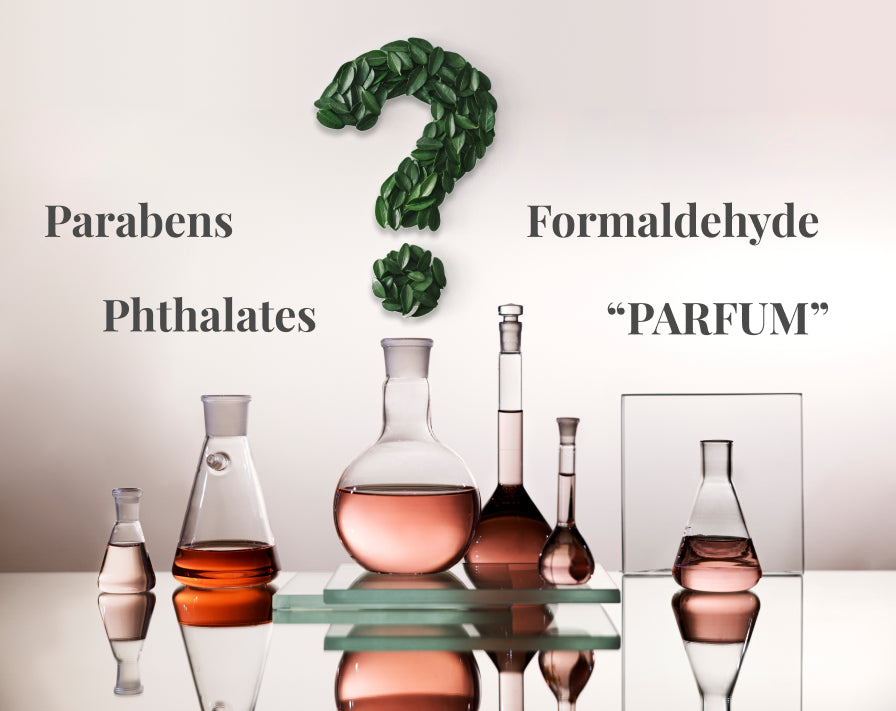
This is cause for alarm. Most consumers aren't even aware that some of the products they use everyday would be considered dangerous by EU standards where regulations are more in sync with current research and findings. While Health Canada has banned or restricted the use of over 500 different chemical ingredients in our cosmetics (currently-banned chemicals can be found on "Canada’s "Cosmetic Ingredient Hotlist"), we are still very behind the EU. The EU has banned around 2,000 ingredients for health and safety concerns . In the USA, it's pretty bleak at just over 300 chemicals banned.
According to a joint press release issued on April 25, 2023 by ClientEarth and European Environmental Bureau:
"Exactly a year ago, the European Commission announced it would rapidly ban thousands of the most notorious chemicals still found in consumer products and contributing to growing human infertility, serious illnesses and environmental harms... Overall, as many as 7,000 chemicals could be banned under the roadmap by 2030, a huge step up on the roughly 2,000 the EU has phased out over the last 14 years, more than any other world region."
What gets me about this particular press release is, they state that they consider this to be a failure as far more chemicals need to be banned, and it isn't happening fast enough. And yet, they are so far ahead of us!!
Although there is so much new research proving that chemicals like parabens and toluene are absolutely horrible for our health [4] [6], our governments' regulatory bodies in Canada and the USA are not treating this like the priority it should be.
Chemicals known to cause harm to human health and the environment need to be eradicated as it threatens our very existence on Planet Earth.
Below is a "cheat sheet" list of toxic chemicals you should avoid, and why.
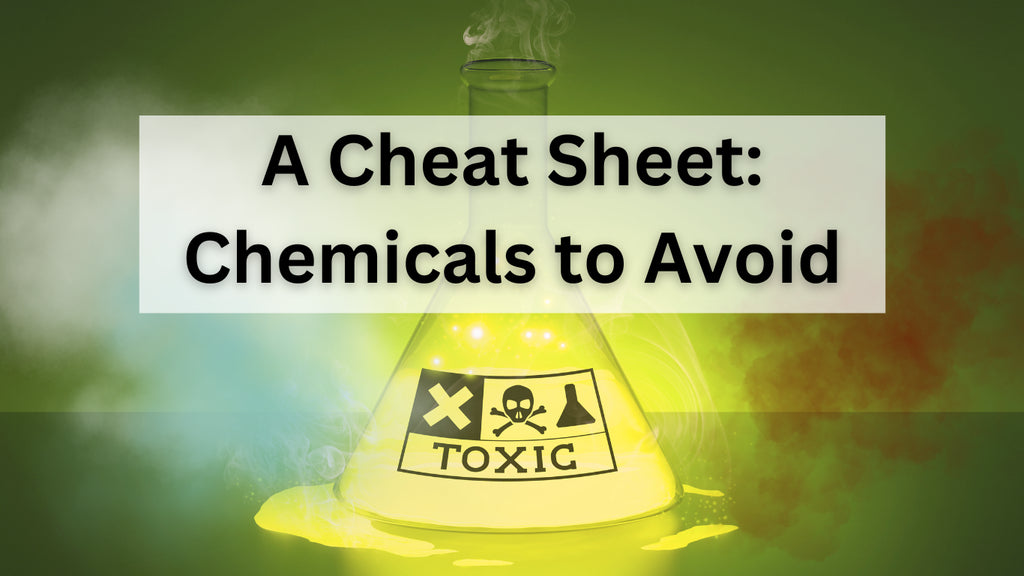
⚠️"Fragrance" and "Parfum" - be aware, it could be chemical soup
So you've read the product's ingredient list and haven't found any "nasties" listed. But that doesn't mean they aren't present.
Although many ingredients are still technically banned in many countries, they could still be present and hiding in the ingredient "fragrance" or "parfum". This is a manufacturing regulation "trade-secret-protection-loophole" where toxins are allowed without being individually listed, if they are a component of a scent mix. (So you'll never actually know, just like the famous secret recipe for Cola). You could have allergens, animal by-products, petrochemicals or worse: something like toluene that actually smells sweet [6]. In 1991, the EPA (Environmental Protection Agency) conducted a study and found that 100% of fragrances tested contained toluene.
To summarize: "Fragrance" and "Parfum" are basically catch-all terms where toxins can be hiding, even when the label claims the product is "all natural". "Fragrance" and "parfum" on a product's ingredient label are two terrifying words which can amount to any type of "chemical soup", so be aware.
⚠️Avoid These Toxic Ingredients Found in Common Household Products and Cosmetics
🛑Aluminum:
Blocks your sweat glands and is easily absorbed by the skin. Over time, the accumulation can lead to neurological problems such as Alzheimer’s disease [7] and cancer [8]. Although there is so much research linking it to harm, aluminum is still found in many deodorants and antiperspirants.
🛑Asbestos & Talc:
Asbestos - while not always, can be found in talc, including in baby powder, makeup and cosmetics. This is because talc is a natural mineral that occurs in the earth close to asbestos, and so traces of asbestos can found in talc due to their proximity to each other and during the mining process.
Inhalation of asbestos causes lung diseases and cancer. Even if a manufacturer is honestly well-intended and the cosmetic is "all natural" (both talc and asbestos are all natural), it is next to impossible to tell if asbestos is present in trace amounts, without actually lab testing the product. Regulations surrounding the testing of cosmetic-grade talc are lax. Talc-free makeup is always the very safest option. [9]
🛑BPA ("Bisphenol A"):
Often referred to as an "everywhere" and "forever chemical", it is found in everything from being an ingredient, plasticizer, antioxidant, a coating agent, to even in the plastic or paper packaging itself. You'll find it in cosmetics, menstrual products, plastic bottles, electronics and even printer receipts.
The trouble with BPA is that it behaves like a synthetic estrogen in the human body; wreaking havoc on hormones, cell repair, thyroid, fetal development, brain function and the overall endocrine system. It has been associated with infertility, heart disease, diabetes and more. [10]
🛑Ethoxylated ingredients (ingredients that contain the three letters “-eth-"):
This includes certain preservatives, polysorbates and SLS/SLES. Examples are ingredients that end in or contain –eth- such as laureth, steareth, ceteareth, as well as polysorbates, PPG (polypropylene glycols) and PEG (polyethylene glycols). They’re present in a lot of products we use in our daily lives, like shampoo, bubble bath and liquid soaps. The problem is that the process to create these chemicals involves a reaction with ethylene oxide, which is known to be highly carcinogenic and can remain as a contaminant in the final product after manufacturing.
🛑Formaldehyde and "Formaldehyde releasers":
Formaldehyde is a human carcinogen and broadly accepted by regulatory bodies as being linked to causing cancers and leukemia. Formaldehyde releasers are chemicals that are added as preservatives and release formaldehyde in a formula, such as Quaternium-15 and DMDM hydantoin [11]. Formaldehyde releasers can be found in many common cosmetics from nail polish and acetone, sunscreen, lotion and makeup, to even baby shampoo!
🛑Fragrance / 'parfum':
Most synthetic fragrances found in products are derived from petrochemicals and can be very harmful to human health. They can also disrupt hormone activity, reduce sperm count, and cause reproductive malformations. (As mentioned, this ingredient name "fragrance/parfum" has the potential to be "chemical soup", and is where the inclusion of other toxic chemicals may be hidden and not listed individually, under trade-secret protection laws.)
🛑Parabens:
Often used as preservatives in products, and present in 90% of products found in grocery stores. [12] Bioaccumulation of parabens in the human body is great concern. As they mimic estrogen in our systems, they can act as endocrine disruptors and are currently being studied for connections to breast cancer [4].
🛑PFAs:
Per- and Polyfluoroalkyl Substances (or "PFAS") in cosmetics are of significant concern. PFAs are considered another "forever chemical" that bioaccumulates in our bodies and the environment. PFAs are added to cosmetics, makeup, shampoos, conditioners, cleansers, packaging and more; adding a sheen and smooth texture. They can also be present in trace amounts as a result of raw material impurities, and even in drinking water and food like fish, as a result of bioaccumulation in the environment. Multiple studies are underway internationally to assess the extent to which they damage reproductive ability, cause cancer, cause developmental delays in children, reduce immunity, increase obesity and act as endocrine disruptors in human health. PFAs - a man-made group of chemicals and chemical compounds - should be avoided at all costs. [13] You can find a list of these PFA chemicals by name on the US Environmental Protection Agency's website here.
🛑Phthalates:
Also known as “plasticizers” and often used as a solvent or binding agent. Over time, phthalates can build up in our bodies, resulting in a myriad of health issues from endocrine disruptions, damage to reproductive organs and respiratory systems, and even cognitive function damage. [15]
🛑SLS/SLES/Sulfates:
The "Sodium Lauryl" and related sulfate chemicals group are known to easily penetrate the skin's dermal layers and enter the bloodstream - due to their small molecular size - and are often used to create the foaming agent in products.[16]
They’re typically found in toothpaste, shampoo, shaving cream, and body wash. While there are many conflicting claims and studies about this ingredient in its various forms and names, SLS and SLES have been banned in the EU but not yet in Canada or the USA. These claims surround its environmental sustainability, aquatic toxicity, ability to cause skin sensitivity, increase absorption of other chemicals in a formula (such as parabens), endocrine disruption, neurotoxicity, bioaccumulation, hair loss and even cancer.
🛑Toluene:
Toluene can be found in nail polish, cleaning products, solvents, gasoline, paints, dyes, and even in "fragrance" or "parfum".
According to the CDC (Centers for Disease Control and Prevention): "Exposure to toluene can cause eye and nose irritation, tiredness, confusion, euphoria, dizziness, headache, dilated pupils, tears, anxiety, muscle fatigue, insomnia, nerve damage, inflammation of the skin, and liver and kidney damage."[17]
Toluene is a well-studied hazardous and toxic chemical, with too many negative endocrine, organ, reproductive and general health impacts to list.
Be part of "The Toxic Chemical Rebellion" - how to bring about lasting change 💚
It's time for action. Dollars talk. If we stop buying, companies will be forced to stop making. This is a very tangible way to get involved and be a part of the change. Start first by just not buying from companies that make products containing harmful chemicals. And, the reverse is true: start buying from companies that are choosing to put their foot down and are refusing to formulate with chemicals linked to harm. Be selective of where you spend your dollars and the companies you want to empower.
Second, spread the word!! Most people aren't even aware of the dangers of chemicals in their products, or that our standards in Canada and the USA are so far behind Europe. Tell your friends and loved ones. Share this post on social media.
Third, write to your local federal politician and raise a formal complaint. Sign petitions. Raise your voice however you can. Support organizations that are lobbying our governments for policy changes on the regulation of chemicals in our consumer products such as Environmental Defence, Eco Justice, David Suzuki Foundation, EDAction and more. These organizations are to thank for many of the improvements already scheduled to be made soon to our Environmental Protection Acts and lists of banned chemicals by our national health regulatory bodies.
The challenge: it's not easy (or cheap) to create truly CLEAN products that are shelf-stable
Our mission, and the reason we started our company Elva's All Naturals was to create a line of truthfully green, clean and all-natural formulas that our customers can trust and use with confidence - without fear of harm to themselves, their families or the environment. A place where people could shop for their basic household needs, and without fear of harm from toxic chemicals and while reducing plastic and waste.
When we started (and knowing all the chemicals we could not include), we were shocked (!) by the shortlist of ingredients we were left with to produce non-toxic, stable and truly all-natural products. Products that were actually beneficial and supported our health, vs. taking away from it. And that unlike some home-made formulations, would be safe to use and shelf-stable, without the addition of toxic preservatives. It was a major challenge, I'll tell ya'!
But since we refuse to use toxic preservatives and chemicals linked to harm, it really required thinking outside the box. It meant going right back to using ingredients straight from nature, applying new scientific innovations (with the help of some brilliant chemists!) in the creation of our natural formulations, and applying herbal knowledge that has been used across many cultures for hundreds (sometimes thousands) of years. For example, that's why you'll find our cleaning products are made from the herb soapwort, which can be traced back to the stone age as a natural cleaner, laundry detergent and soap!
Elva’s All Naturals offers affordable non-toxic skincare solutions and non-toxic home products. We do NOT test on animals, and all of our formulations are 100% biodegradable and septic-safe.
We don't use the term "all-natural" lightly — we maintain our integrity by ensuring we can stand by our claims, keeping up with our research and providing full disclosure on every ingredient and product label we offer. We’re proud to be part of a more significant movement we call “The Toxic Chemical Rebellion”: a growing group of people and companies committed to environmental and social justice by removing toxic chemicals from household consumer goods.
So, our focus at Elva’s All Naturals’ is twofold: 1) ensuring toxic ingredients are nowhere near our products and 2) creating climate-friendly packaging that reduces waste and plastic pollution through offering refillable formats in glass, recycled cardboard and aluminum. We’re always looking for new and innovative ways to make our products better by asking ourselves, “how do we take the waste out of this?” and “would this be safe for my loved ones to use, based on what we know NOW?”
Help you and your family make healthier, more environmentally friendly choices. By educating yourself on the dangers of toxic ingredients and the regulations surrounding what's in your household and personal care products, you can go green and CLEAN — the right way. 💚
Additional Helpful and Recommended Resources:
Read: "Toxic Cosmetics: Ingredients and Contaminants to Avoid" - an important resource from Beauty Schools Directory on chemicals to avoid and why
Watch: "Toxic Beauty" , an exposé and shocking 2019 CBC Documentary on the effects of harmful chemicals in our personal care products
[9] Read: "Asbestos in Makeup" and "Talcum Powder and Asbestos" - brought to you by The Mesothelioma Center's Abestos.com educational website, on avoiding asbestos in personal care and makeup products
Read: "Talc and Ovarian Cancer" - brought to you by The Lanier Law Firm. This is the firm who secured a $4.69 billion verdict for 22 women and their families in the 2018 winning lawsuit against Johnson & Johnson
Read: "Our Current Understanding of the Human Health and Environmental Risks of PFAS", United States Environmental Protection Agency (EPA) website
Read: "Strengthening Canada’s legal framework to reduce human health risks from toxic substances", Nov.2015, Environmental Law Association, EcoJustice, Environmental Defence, David Suzuki Foundation
Read: "PFAS in Cosmetics", brought to you by Consumernotice.org, a Consumer Advocacy Organization
References:
[1] "Toxic Beauty", Apr.1,2020, Harvard Health Publishing, Harvard Medical School
[2] "Target analysis and suspect screening of UV filters, parabens and other chemicals used in personal care products in human cord blood: Prenatal exposure by mother-fetus transfer", Mar.1, 2023, National Center for Biotechnology Information, National Library of Medicine
[3] "Why Are Trace Chemicals Showing Up in Umbilical Cord Blood?", Sept.1, 2012, Scientific American
[4] "Concentrations of parabens in human breast tumours", 2004, National Center for Biotechnology Information, National Library of Medicine
[5] "Talc and Ovarian Cancer" - brought to you by The Lanier Law Firm. This is the firm who secured a $4.69 billion verdict for 22 women and their families in the 2018 winning lawsuit against Johnson & Johnson
[6] "Evaluation of pollutants in perfumes, colognes and health effects on the consumer: a systematic review", June 2022, National Center for Biotechnology Information, National Library of Medicine
[7] "Link between Aluminum and the Pathogenesis of Alzheimer's Disease: The Integration of the Aluminum and Amyloid Cascade Hypotheses", Mar.8 2011, National Center for Biotechnology Information, National Library of Medicine
[8] "An earlier age of breast cancer diagnosis related to more frequent use of antiperspirants/deodorants and underarm shaving", Dec.2003, European Journal of Cancer Prevention
[9] "Asbestos in Makeup" and "Talcum Powder and Asbestos" - brought to you by The Mesothelioma Center's Abestos.com educational website, on avoiding asbestos in personal care and makeup products
[10] "What Is BPA? Should I Be Concerned About It?", Updated Jan.2024, SaVanna Shoemaker, Alina Petre, HealthLine.com
[11] "Formaldehyde And Formaldehyde-Releasing Preservatives", brought to you by the Campaign for Safe Cosmetics' educational website
[12] "What Are Parabens?', Feb.26, 2019, Rachel Ross, LiveScience.com
[13] "Our Current Understanding of the Human Health and Environmental Risks of PFAS", United States Environmental Protection Agency (EPA) website
[14] "Per and Polyfluoroalkyl Substances (PFAS) in Cosmetics", United States Environmental Protection Agency Website
[15] "Phthalates and Their Impacts on Human Health", May 18, 2021, Yufei Wang and Haifeng Qian, National Center for Biotechnology Information, National Library of Medicine
[16] "Quantification of sodium lauryl sulfate penetration into the skin and underlying tissue after topical application--pharmacological and toxicological implications", Oct.1995, S Patil, P Singh, K Sarasour, H Maibach, National Center for Biotechnology Information, National Library of Medicine
[17] "Toluene", online article from The National Institute for Occupational Safety and Health (NIOSH), Centers for Disease Control and Prevention
